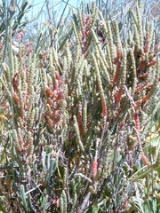
Sarcocornia
Encyclopedia
Sarcocornia is a genus of succulent salt tolerant
coastal plants.
Halophyte
A halophyte is a plant that grows where it is affected by salinity in the root area or by salt spray, such as in saline semi-deserts, mangrove swamps, marshes and sloughs, and seashores. An example of a halophyte is the salt marsh grass Spartina alterniflora . Relatively few plant species are...
coastal plants.
Species
- S. alpini
- S. blackiana (Thick-head Glasswort) (AustraliaAustraliaAustralia , officially the Commonwealth of Australia, is a country in the Southern Hemisphere comprising the mainland of the Australian continent, the island of Tasmania, and numerous smaller islands in the Indian and Pacific Oceans. It is the world's sixth-largest country by total area...
) - S. fruticosa
- Sarcocornia globosa (Australia)
- Sarcocornia pacifica (Pacific Swampfire or Pacific Glasswort) (United StatesUnited StatesThe United States of America is a federal constitutional republic comprising fifty states and a federal district...
) - Sarcocornia perennis (Chickenclaws, Perennial Glasswort, Virginia Glasswort) (United States)
- S. perennis subsp. alpini
- S. perennis subsp. perennis
- Sarcocornia pulvinata
- Sarcocornia quinquefloraSarcocornia quinquefloraSarcocornia quinqueflora, commonly known as Beaded Samphire, Bead weed or Beaded Glasswort, is a species of succulent halophytic coastal shrub...
(Australian Samphire or Beaded Glasswort) (Australia)- S. quinqueflora subsp. quinqueflora
- S. quinqueflora subsp. tasmanica
- Sarcocornia utahensisSarcocornia utahensisSarcocornia utahensis is a species of flowering plant in the amaranth family known by the common name Utah swampfire. It is native to the southwestern United States, where it can be found in desert habitat, generally in areas with alkaline or saline soils, such as playas...
(Utah Swampfire) (western United States)

